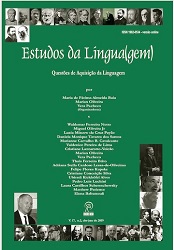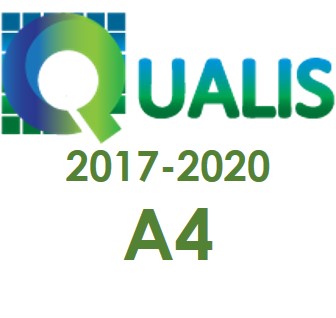Rethinking the effects of age on L2 phonic development
DOI:
https://doi.org/10.22481/el.v17i2.5340Keywords:
Phonic development; Second Language; Critical Period; Input.Abstract
One of the most pressing concerns in the area of L2 acquisition concerns the age at the onset of bilingualism/acquisition (AOA). Classical studies point to a negative correlation between AOA and accuracy and proficiency in the L2. However, recent experimental research has problematized this hypothesis. In this perspective, this work, result of research funded by CNPq, presents data on L2 development by immigrants in L2-dominant contexts that contradict the hypothesis that the success of L2 phonic development is conditioned by neurocognitive maturation. The data reveal that the variation in input is the most important variable in the prediction of success in L2 development. The potential of AOA as a predictor of foreign accent or success in L2 comes from its association with quantity and quality of input received by immigrants/learners.
Downloads
References
BECKNER, C. et al. Language is a complex adaptive system: position paper. Language Learning, v. 59, n. 1., p. 1-26, Dec., 2009.
BEN-RAFAEL, M.; SCHMID, M. Language attrition and ideology: Two groups of immigrants in Israel. In KOPKE, B.; SCHMID, M. S., KEIJZER, M.; DOSTER, S., (ed). Language attrition: Theoretical Perspectives, Amsterdam/Philadelphia: John Benjamins, 2007, p. 205-226.
BEST, C.; TYLER, M. Nonnative and second-language speech perception: commonalities and complemen- tarities. In: BOHN, O.; MUNRO, M.. Language Experience in Second Language Speech Learning: In honor of James Emil Flege. Amsterdam: John Benjamins, 2007. p. 13-34.
BIRDSONG, D. Interpreting age effects in second language acquisition. In. KROLL, J.; GROOT, A. (Eds). Handbook of bilingualism: Psycholinguistic perspectives. Oxford: Oxford University Press, 2005, p. 109-127.
BYBEE, J. Phonology and Language Use. Cambridge: Cambridge Univ. Press., 2001.
CHISWICK, B.; MILLER, P. (2001) A model of destination language acquisition: Application to male immigrants in Canada. Demography, 38 (3), p. 391-409, 2001.
De LEEUW, E. 2014, Maturational constraints in bilingual speech. In THOMAS E. M.;
EVANS, B.; IVERSON, P. Vowel normalization for accent: An investigation of best exemplar locations in northern and southern British English sentences, J. Acoustical Soc. America, 115, 352– 361, 2004
FLEGE, J. E. Second language speech learning: Theory, findings, and problems. In
GARDNER, R. C. Social Factors in Language Retention. In: R. D. Lambert & B. F. Freed (eds.). The Loss of Language Skills. Rowley: Newbury House, 1982, p. 24-39.
GIBSON, J. The ecological approach to visual perception. Boston: Houghton Mifflin, 1979.
HAUGEN, E. The ecology of language. In FILL, A.; MÜHLHÄUSLER. P. (Orgs.) The ecolinguistics reader (p. 57-66). London: Continuum, 2001.
HOPP, H.; SCHMID, M. S. Perceived foreign accent in L1 attrition and L2 acquisition: the impact of age of acquisition and bilingualism. Applied Psycholinguistics., 2013.
JOHNSON, J.; NEWPORT, E. Critical period effects in second language learning: The influence of maturational state on the acquisition of English as a second language. Cognitive Psychology, 21(1), p. 60–99, 1989.
KUPSKE, F.. Imigração, Atrito e Complexidade: a produção das oclusivas surdas iniciais do inglês e do português por brasileiros residentes em Londres. (Doctoral Dissertation) Universidade Federal do Rio Grande do Sul, Porto Alegre, Brazil, 2016.
______. A complex approach on integrated late bilinguals English VOT production: a study on south Brazilian immigrants in London. Ilha do Desterro, v. 70, p. 81-94, 2017.
______. Atrito de L1 por assimilação de categorias fonéticas da L2 na produção da fala de imigrantes de primeira geração. In: ATAIDE, C. A.; SOUSA, V. V.. (Org.). Língua, texto e ensino: descrições e aplicações. 1ed. Recife: Pipa Comunicação, 2018, p. 605-614.
LENNEBERG, E. Biological Foundations of Language, New York: Wiley, 1967.
MASGORET, A.; GARDNER, R. Attitudes, motivation, and second language learning: A meta-analysis of studies conducted by Gardner and Associates. Language Learning, 53(1), p. 123-163, 2003.
MCCARTHY, K.; EVANS, B.; MAHON, M. Acquiring a second language in an immigrant community: The production of Sylheti and English stops and vowels by London-Bengali speakers. Journal of Phonetics, 41, p.344–358, 2013.
MOYER, A. Ultimate attainment in L2 phonology. Studies in Second Language Acquisition, 21, 81–108. 2009.
MUÑOZ, C.; SINGLETON, D. Foreign accent in advanced learners. Two successful profiles. The EUROSLA Yearbook 7, p. 171-190, 2007.
OPITZ, C. First language Attrition and Second Language Acquisition in a Second- Language Environment. PhD dissertation, Trinity College Dublin, 2011.
SANCIER. M. L.; FOWLER, C. A. Gestural drift in a bilingual speaker of Brazilian Portuguese and English. Journal of Phonetics, 27 (4), p. 421–436, 1997.
SCHMID, M. Second Language Attrition. In BROWN, K. (Ed.). The Encyclopedia of Language and Linguistics, (Vol. 11, p. 74-81). Amsterdam: Elsevier. 2006.
______; de BOT, K. Language Attrition. In DAVIES, A.; ELDER, C. (Eds.), The Handbook of Applied Linguistics. Oxford: Blackwell Publishing, 2006, p. 210-234.
______; MEHOTCHEVA, T. H. Foreign Language Attrition. Dutch Journal of Applied Linguistics, 1 (1), p. 102-124, 2012.
______; GILBERS, S; NOTA, A. Ultimate attainment in late second: Phonetic and grammatical challenges in advanced Dutch-English bilingualism. Second language research, 30(2), p. 129-157, 2014 <DOI: 10.1177/0267658313505314>
STEVENS, G. Age at immigration and second language proficiency among foreign-born adults. Language in Society, 28, p. 555-578, 199.
______. The Age‐Length‐Onset Problem in Research on Second Language Acquisition Among Immigrants. Language Learning, 56 (4), p. 671–692, 2006
SINGLETON, D.; RYAN, L. Language Acquisition: The Age Factor. Second Edition. Clevedon: Multilingual Matters, 2004.
VAN HOUT, R.; STROMQUIST, V. The Influence of Socio-Biographical Factors. Adult Language Acquisition. Cross-linguistic perspectives. C. Perdue. Cambridge, Cambridge University Press. 1:p.164-172., 1993.
van TUBERGEN, F. Determinants of second language proficiency among refugees in the Netherlands. Social Forces, 89(2), p. 515–534, 2010.
______; WIERENGA, M. The language acquisition of male immigrants in a multilingual destination: Turks and Moroccans in Belgium. Journal of Ethnic and Migration Studies, 37(7), p. 1039–1057, 2011.
VENTUREYRA, V.; PALLIER, C., YOO, H. The loss of first language phonetic perception in adopted Koreans. Journal of Psycholinguistics, 17, p. 79–91, 2004.
YILMAZ, G.; SCHMID, M. Second Language Development in a Migrant Context: Turkish community in the Netherlands. International Journal of the Sociology of Language, 236, p. 101-132, 2015.
ZIMMER, M.; ALVES, U. A produção de aspectos fonético-fonológicos da segunda língua: instrução explícita e conexionismo. Linguagem & Ensino (UCPel), v. 9, p. 101-143, 2006.
Downloads
Published
How to Cite
Issue
Section
License

Estudos da Língua(gem) is licensed under a Creative Commons Attribution 4.0 International License.
Authors who publish in the journal Estudos da Língua (gem) agree with the following terms:
The journal Estudos de Língua(gem) maintains the copyrights of the contributions published. These rights include the publication of the contribution and make its content available for free through the portal.













